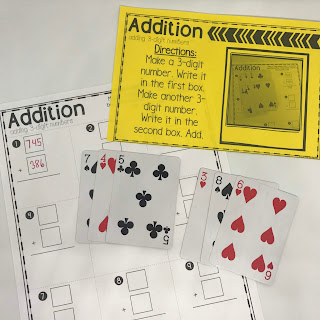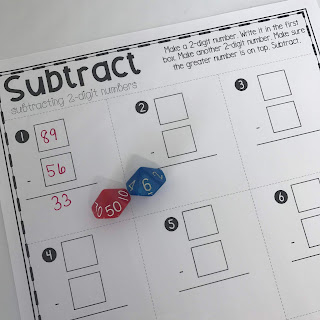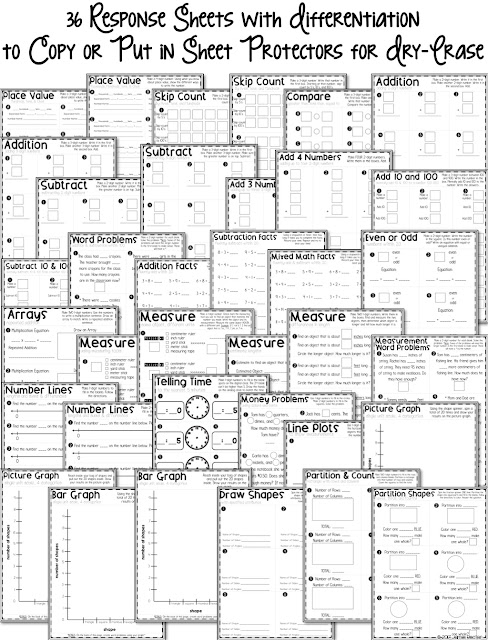Board Games + Math Problems = Fun:
Students work in pairs to solve the math problem on the task card, flash card, worksheet, etc. and when they BOTH arrive at the correct answer, Partner A gets a turn on the game board if they got the answer correct. Let me reiterate that both students solve the problem, but only one student moves on their turn if their answer is correct. If it's incorrect, the students must work together to find the mistake. Then it's the next partner's turn. The same rules apply. Both students work to solve the problem, but if Partner B gets it correct, they get to take a turn on the game board. This keeps both students engaged the entire time even if it's not their turn to utilize the game board.
For your convenience, I've linked to several inexpensive game boards on Amazon. These are affiliate links and the pictures below are also clickable links.





"Done for You" Math Centers:
In the world of social media, cute fonts and graphics, and digital downloads, I think we have lost the brilliance of math centers that are pre-packaged and ready for your students to use immediately. Not only do these types of math centers last for years, they are also extremely versatile. I will share my favorites with [affiliate] links to where they can be purchased. Some of these I have literally had for years and pulled them back out because they can be used over and over with a simple change of content. Even better is that all of them are self-checking!
- Hot Dots - addition, subtraction, multiplication, Hot Dots pen
- Self-Checking Math VersaTiles - Grade 1, Grade 2, Grade 3, Grade 4
- Flash Cards - addition, subtraction, multiplication
- Electronic Flash Card Device - all operations



Electronic Flash Card Device:

Math Centers with Dice, Cards, and Spinners:
Do you already have dice, playing cards, and spinners? If so, you can easily use these items for math centers, but most importantly they can be used to DIFFERENTIATE your math centers! Say what??? This resource was designed with the busy teacher in mind! These centers are EASY PREP, LOW COST, and TIME-SAVING! The centers in this file can all be used with items you probably already have in your classroom or at home - dice, playing cards, and spinners. If not, the materials are super cheap and easy to prep. All task cards and recording sheets are available to print in black and white to save paper, lamination, and printer ink. The centers can also be used year-round, rather than seasonal. Switch them out as needed! The design of the centers allows for easy differentiation to meet all your learners’ diverse needs. You can check them out [HERE] or keep reading to see how easy these centers are for a budget-friendly math center option! When people ask me how to implement guided math on a budget, this is how!
Amazon [affiliate] links and clickable picture links to the dice, cards, and spinners I use in my classroom below.
Amazon [affiliate] links and clickable picture links to the dice, cards, and spinners I use in my classroom below.
Download the Preview File in my TPT Store [HERE] for a sneak peek into this resource, also found below. You can also check out my blog post [HERE] for a detailed overview of this product as well.
Differentiation by Spinner Choice:
3-digit addition using the 1-9 spinner
use 1-4 spinner for no regrouping, 0-9 for regrouping
use 0-9 for subtraction across zeros and 1-9 for no zeros
inexpensive option - use a pencil and paperclip rather than a spinner overlay
Differentiation by Card Choice:
3-digit addition WITHOUT regrouping using cards 4 and lower
3-digit addition WITH regrouping using cards up to 9
use the ten frame cards provided for additional support
task card with visual cues
Differentiation using Dice:
subtraction using place value dice
addition with dice 6 and below
variety of dice can be used for differentiation
task card with visual cues
Read more about managing the differentiation below.
For an easy way to differentiate, you can purchase colored paper through my affiliate link [HERE].
Read more about how these math centers will make your life easier below.
Each center task can be printed on a half-sheet of paper in black and white. There are full color visual cues on the center task cards as well to help remind your little learners of the directions.
Just add dice, spinners, or cards! It's that easy!
So that's how I manage my math centers without breaking the bank or spending hours prepping! From board games and pre-packaged "done for you" math centers to differentiated math centers with dice, playing cards, and spinners, this is manageable for me. My students are fully engaged in their math centers during Guided Math rotations which allows me to better meet the needs of my students during small group math instruction.
And that wraps up my 3-part blog series all about how to implement Guided Math in the 2nd Grade Classroom! I sure hope you have enjoyed this series and have learned everything you need to know to get Guided Math up and running in your classroom. If you implement Guided Math in your classroom and use any of the strategies and tips you have learned here, PLEASE share about it and tag me on your social media accounts! I would LOVE to share your success with others! Please let me know if you have any questions. Thanks for spending your time with me!
And that wraps up my 3-part blog series all about how to implement Guided Math in the 2nd Grade Classroom! I sure hope you have enjoyed this series and have learned everything you need to know to get Guided Math up and running in your classroom. If you implement Guided Math in your classroom and use any of the strategies and tips you have learned here, PLEASE share about it and tag me on your social media accounts! I would LOVE to share your success with others! Please let me know if you have any questions. Thanks for spending your time with me!
Need to catch up on Parts 1 and 2 in this blog series? [click below]
Part 1:
Part 2:
Pin this Image to Save for Later:
Amazon Affiliate Disclosure: 2nd Grade Stuff is a participant in the Amazon Services LLC Associates Program, an affiliate advertising program designed to provide a means for us to earn fees by linking to Amazon.com and affiliated sites. If you click on an affiliate link on this blog and purchase, Amazon will toss a few coins my way, at no extra cost to you, to help keep this blog up and running.

















































No comments